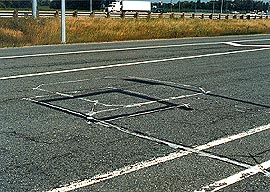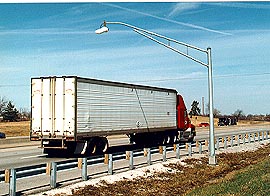|
|
|
กก
CVISN: The Information Highway Meets the Asphalt Jungle
กก
by Michael Curtis and Jeff Secrist
For the past decade, much has been made of the American workplace's transition to a paperless environment. Personal computers and the networks that bind them have automated many formerly tedious processes, improved operating efficiencies, and facilitated innumerable business processes.
But for many Americans - specifically operators of those mobile office environments known as commercial vehicles - computer automation has taken longer to achieve mainstream acceptance and adoption into the everyday work world. Although numerous computer systems are simplifying the lives of truckers and administrators alike, few of these systems "speak" to each other via the common operating standards and open systems network architectures that are the hallmarks of most major industries. While some trucking companies, such as the United Parcel Service, are spearheading the implementation of new technologies when it clearly makes business sense, these internal systems are unintegrated "islands" of technology.
The Federal Highway Administration (FHWA) wants to change that, and one of the ways it intends to start is through a new network architecture known as CVISN (pronounced like "see vision") - Commercial Vehicle Information Systems and Networks - for the trucking industry.
Essentially, CVISN is an attempt to link the disparate intelligent transportation systems (ITS) technologies already impacting the world of commercial vehicle operations (CVO) under a single operating umbrella. Without such a link or network, those ITS computer systems would continue to operate in a stand-alone capacity, much like a roomful of personal computers unable to communicate with each other except through the exchange of hardcopy printouts.
Many Systems, One Open Network
By its very nature, trucking is an information-intensive industry. Unlike automobiles,
trucks must register in every state in which they operate. In addition, safety, tax
administration, and freight information also must be shared between myriad organizations,
government agencies, and other CVO stakeholders.

For example, when a truck enters a new state, at some point it may be stopped to ensure that it has the proper operating permits or paperwork pertaining to registration, fuel tax, oversize/overweight status, hazardous materials, insurance, and U.S. Department of Transportation (DOT) authorization. Manually checking for that information can be cumbersome and time-consuming, tying up resources better spent on other operations and services. Carriers and the state and federal authorities to whom they answer invest an inordinate amount of time and money to share paper-based information that could be disseminated/collected more easily, effectively, and affordably through an electronic interface.
"Traditionally, states would ship whole rooms full of documents to each other," notes Doug McKelvey, assistant chief of the CVO/ITS Division in FHWA's Office of Motor Carrier Safety and Technology. "CVISN is a way to automate these burdensome manual processes and make life easier for all CVO stakeholders." In other words, CVISN is the means to enable the trucking industry to keep up with the other traffic on the information highway.
Over the past few years, technology has facilitated some commercial vehicle operations, automating processes that in the past took weeks or even months to complete. For example, programs and intelligent technology - such as the Commercial Driver License Information System (CDLIS), the Heavy Vehicle Electronic License Plate (HELP), the International Registration Plan (IRP), and the International Fuel Tax Agreement (IFTA) clearinghouses' support a number of CVO functions.
Bringing It All Together
The missing ingredient was an operating architecture capable of linking these disparate
elements into a single, comprehensive network in which all interested CVO parties would
have a stake. And then came CVISN, the CVO part of the U.S. DOT's overall ITS
architecture.

First conceived in 1996, CVISN was "an obvious winner," says McKelvey. It was envisioned as a program through which the necessary open standards and technical framework could be developed to link ITS/CVO elements into a single architecture that could be shared by the states participating in the pilot study and ultimately, of course, by all CVO interests in North America.
The core CVISN infrastructure is eight key ITS/CVO program functions that involve the exchange of registration, safety, or other important information critical to CVO stakeholders. The functions are: safety information, credentials administration, electronic screening, international border clearance, automated inspection, onboard safety, hazardous materials response, and fleet and freight management.
On the front end of the system, a carrier in one of the 10 pilot states uses a personal computer to transmit an application and electronic payment to the state DOT. The state enters the information in a database and accepts or rejects the application. If accepted, the necessary credentials are issued to the carrier electronically via the Internet. The state also sends the information to roadside screening stations and to a North American clearinghouse for distribution to the entire 57-jurisdiction system.

Ideally, CVISN will facilitate the verification process of all this information through the same transponder technology that now permits the drivers with prepaid toll cards to pass through toll plazas without stopping. Employing a dedicated short-range communication (DSRC) transponder, the truck's information is automatically transmitted and read by state roadside computers, significantly shortening the time and expense involved in such efforts. As McKelvey points out, under the CVISN application, DSRC "provides a link to credentials rather than funding for tolls."
Similarly, roadside safety inspections can be accommodated much more efficiently through a simple scan of the license tag. A computer database quickly alerts police officers about the carrier and/or driver's safety record and operating history. Studies indicate that such software significantly improves overall highway safety by effectively identifying high-risk carriers, enabling police to take the appropriate action.
The carrier also uses the same transponder to pay tolls electronically, and at the conclusion of the trip, a special software program is used to calculate and pay the quarterly tax payment to each jurisdiction involved. This is accomplished through a relatively simple transmission via the Internet.
Once en route, the carrier avoids traditional delays at weigh stations through electronic screenings made at normal travel speeds. The DSRC provides information on vehicle identification, carrier, driver, and specially regulated load type identifiers to roadside readers. These identifiers are used to access information on safety, credentials, taxes, and other key information contained in databases. Carriers who are cleared with this system are exempted from showing paper documentation. In short, the truck is a traveling data file accessible to CVISN users. (See a related article, "Advantage I-75 Prepares to Cut Ribbon on Electronic Clearance," in Public Roads, Autumn 1995.)

Similarly, international border crossings need no longer be a source of interminable delay. Routine trans-border information is transmitted via electronic data interchange (EDI) - usually before the truck reaches the border. When inspections do take place, they can be accomplished quickly and efficiently with automated safety inspection equipment.
This process also accommodates intermodal traffic, including trucks, railroads, ships, and air freight. With each trailer and shipping container containing a standard intermodal registration tag, the same information is available to authorities throughout the transportation life of the freight. A state inspector, for example, could scan the container tag and receive the same information he usually gets from the truck itself.
Key CVO stakeholders are quickly adopting CVISN technology. Carriers, in particular, are interested in automating resource-intensive administrative processes. Carriers can use CVISN technology to augment their own fleet management practices, including scheduling, routing, and maintenance information.
CVISN at 2005 and Beyond
It is the fervent hope of McKelvey and his CVISN colleagues that by the year 2005, the
vast majority of CVO business transactions will be administered electronically. CVISN
users will include the carriers themselves, shippers, state and federal government
agencies, insurance companies, and other industry stakeholders.

Insurance companies, for example, "can subscribe and will receive data when the status changes on a carrier's safety record," says McKelvey. "The new data that is made available will create all kinds of new applications. The sky's really the limit with this technology."
McKelvey added that the open architecture and Internet accessibility could raise security concerns. "There are always going to be privacy issues involved." Nevertheless, he doesn't see it as a major concern. Although some states are pushing for adoption of a closed, wide-area network architecture, FHWA is "really trying to sell the Internet. The Internet is better, faster, cheaper, and ubiquitous. And security concerns are being addressed," he said.
For now, CVISN is being tested in a number of pilot states. But McKelvey and other CVISN proponents hope to include more states as Congress supplies additional funds. Program oversight shifted to DOT's Office of Motor Carriers as work shifted from research and development to deployment.
Early research indicates broad acceptance by many CVO stakeholders, particularly those who are younger and more flexible regarding the use of computer and Internet technology. Carriers, for example, are excited about reducing the cost and time burdens involved in administrative issues, such as registration. They also favor the of safety services.
McKelvey said CVISN is following a phased implementation. Maryland and Virginia, as prototype states, are currently developing and deploying components of safety information exchange, credentials administration, and roadside electronic screening. Our goal is for the prototype states to demonstrate these capabilities by the end of 1999. Eight more pilot states - California, Colorado, Connecticut, Kentucky, Michigan, Minnesota, Oregon, and Washington - are also working to reach full operational status by the end of 2000.
Ultimately, the project will expand to encompass other "partner" states and then, finally, to any and all interested states. With any luck, by 2005, the trucking industry will be traveling in the fast lane of the information superhighway.
Michael Curtis is a research engineer in the Intelligent Systems and Technology Division of FHWA's Office of Safety and Traffic Operations Research and Development (R&D). His training and experience is in program management and computer engineering, and he has an extensive background in the development of state-of-the-art computer and communication systems. He is currently the FHWA R&D program manager for development of Commercial Vehicle Intelligent Transportation Systems. In this capacity, he managed the development of the Commercial Vehicle Information Systems and Networks (CVISN) architecture and a prototype of that architecture in Maryland and Virginia. Now, he is providing technical assistance to the CVISN pilot states in support of CVISN deployment.
Jeff Secrist is a transportation specialist in the Intelligent Transportation Systems/Commercial Vehicle Operations Division of FHWA's Office of Motor Carrier Safety and Technology. He is the national coordinator for the CVISN 10-state prototype and pilot deployment program. He is also involved in developing the strategy for the subsequent deployment of CVISN across the nation. He graduated from Virginia Tech in 1987 with a bachelor's degree in business management.